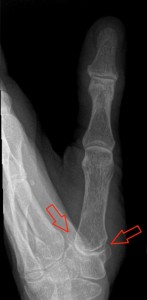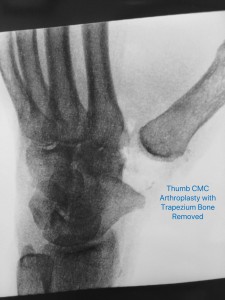Thumb arthritis is a common cause of thumb pain. At the base of the thumb is a special joint called the carpo-meta-carpal (CMC) joint. The thumb CMC gives our thumbs a wide range of thumb motion. The ability to touch the thumb to the small finger is called “opposition.” This function makes human hands special. The base of the thumb is exposed to a large amount of “wear and tear” stress because we use this joint every day. Opening jars, turning a key, wringing out a cloth, all use this area. Over time, this joint can wear out and become arthritic. The normal smooth cartilage wears away, leading to contact between the bones. This can cause pain, weakness, and stiffness. Previous injury and family history of osteoarthritis may also add to this.
Thumb CMC joint arthritis is a common form of degenerative joint disease, also known as osteoarthritis. It is one of the most common places to get osteoarthritis in the hands. Osteoarthritis is more common the older we get, and it is part of the usual aging process.
In the x-rays, the red arrows are pointing to a thumb CMC joint with osteoarthritis. You will see bone spurs on the edges of the joint and decreased space between the bones. The bones are rubbing together because the cartilage has worn away.
Non-operative treatments for thumb arthritis:
- Thumb brace
- Anti-inflammatory pills (NSAIDs)
- Tylenol pills
- Glucosamine and Chondroitin Sulfate dietary supplements
- Turmeric supplements
- Topical medications and creams
- Cortisone injections
- Adjusting hand activities to reduce pain
Reducing inflammation in the joint can relieve the arthritis pain. We do not have a cure for osteoarthritis, but we can treat the pain. Many patients can avoid surgery with adjusting their hand activities, using oral or topical medications, and using a thumb brace. Most patients try a steroid shot into the joint to see if this will provide pain relief.
What surgery is recommended for arthritis?
Surgery may be recommended when non-operative treatment has failed to control the symptoms. The most common type of surgery for thumb CMC arthritis is called “thumb CMC arthroplasty.” The surgery is performed as an outpatient, usually in a surgery center. General anesthesia can be avoided by using a temporary nerve block and sedation. During surgery, the arthritic bone at the base of the thumb (the trapezium bone) is removed. This procedure eliminates the grinding pain between the bones. In addition, a tendon from the patient’s forearm can be used to fill the space at the base of the thumb or reconstruct the ligaments at the thumb base, if needed. This tendon acts as a cushion for the thumb.
For most patients, this surgery provides good thumb range of motion, decreased pain, and good grip strength. Most patients are very happy with the results.
Therapy is needed after surgery. A splint is used protect the surgery site for about 6 weeks. Hand therapists help patients get better range of motion and strength. It can take 3 months to recover.
The image below is taken during surgery. This shows that the trapezium bone has been removed and there is no longer contact between the arthritic bone surfaces. The empty space is filled with a forearm tendon to cushion the thumb base.


